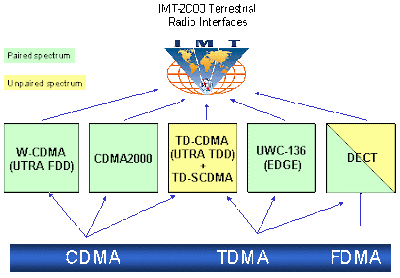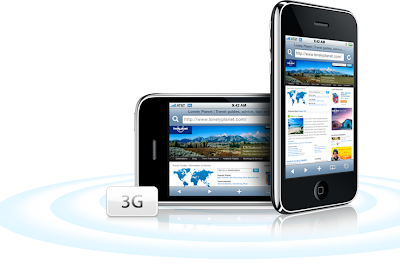
iPhone 3G
Do you think the iPhone 3G is awesome? Well, I can't say I totally disagree, but it seems there are a lot of problems with it, some real, some that may appear in time, while others are nothing more than fiction at this time. While the dock issue is a real one, there are plenty of things to think about, as we're going to see right away

SCREEN PROBLEM
· According to an Apple Store employee, quoted by IntoMobile, your old iPhone dock won't be able to host the new iPhone 3G. As the guy said, "the iPhone 3G is shaped differently and doesn’t fit in the same dock," so you can leave all hope.
Well, at least let's hope someone will manage to come up with a "iPhone dock to iPhone 3G dock converter,"
· If you looked at it off angle any way at all the blacks became a bright blue. At first I thought that it was perhaps just the result of being a brighter screen, but it was really bad, especially in the dark. When viewing photos or movies with dark scenes, tilt the phone away from you at all and blacks become bright blue, washing out the image and giving the “negative black” effect much reported when the iPod touch first launched. My original iPhone’s screen was perfect in comparison. Look at it off angle and it’s fine unless you view it at extremes.
· Some of the complainants consider the yellow-tint to be a firmware issue, while others consider it a hardware problem. Few have noticed that it only happens in the 16GB variant, and by increasing the brightness, it’s not visible. Engadget spoke to a marketing manager of Apple who told them:
o “the screen’s colour temperature has been purposely altered on the new iPhone to produce warmer, more natural tones, sharper images, and deeper blacks”
· There are reports of faulty motion sensors, volume keys, but mostly, yellow tinted displays.
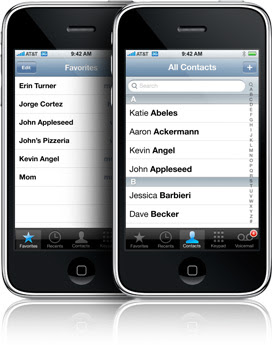
CALLING PROBLEM
· While nobody has formally studied the problem, lots of iPhone 3G users are complaining that they can't find 3G service, can't maintain 3G service in areas where other 3G phones can, witness wildly fluctuating signal strength bars on the phone, or conversely can't use 3G because it consumes battery life too rapidly.
Many articles on the subject are referencing Apple's support forums, where some discussions have gotten so long that forum moderators have had to lock the original thread and create a new overflow discussion.
Clearly, there are real problems. How widespread and common those problems are is more difficult to pinpoint. Apple said it sold a million iPhone 3G units on its opening weekend, and Piper Jaffray analyst Gene Munster reported that each of the company's US retail stores are now selling an average of 95 iPhone 3G sales per day. He expects the company to sell 4.47 million this quarter. That indicates that well over two million iPhone 3G units have already been sold to users.
Even if the 3G issues were only affecting one percent of the phones sold, that would leave twenty thousand users with problems. If only a tenth of those users posted comments online, that would easily account for the two thousand messages on Apple's discussion boards.
· When it arrives, the iPhone 2.1 software is expected to combine firmware optimizations with higher level software updates, including tools to enable developers to work with more accurate GPS data for turn-by-turn directions, as well as the notifications system for third party apps that Apple described at WWDC. The notification feature was reported missing from the fourth iPhone 2.1 beta released to certain iPhone developers just days ago.
Features are frequently added or removed during beta build testing, but the removal of the notifications system from the 2.1 build may relate to an effort to deliver its anticipated low level firmware updates as soon as possible and perhaps sooner than planned, leaving the notification service to be distributed as part of a separate release.
Apple has not publicly connected the notification system with the iPhone 2.1 release; it delivered the details of both under a non disclosure agreement intended to prevent speculation and panic as changes occur in its deployment schedule.
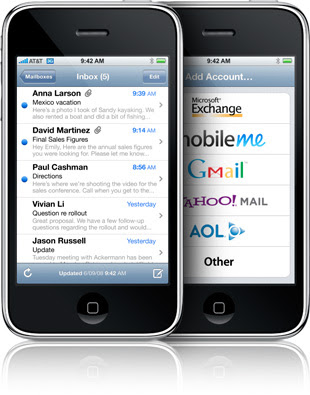
MAILING PROBLEMS
· The Mail program will work as it's supposed to for a day or so. Then, suddenly, it will stop retrieving or sending e-mail. I've taken the iPhone to an Apple store Genius Bar twice to resolve the issue. The first time, the 'Genius' was perplexed and said there must be something wrong with my ISP's e-mail setting (AT&T Yahoo is the ISP for my primary e-mail account). His solution: Call AT&T for help.
· I tweaked some settings on my own and the Mail program worked again. For about a day. I took it to a different Apple store. This time, the Genius said there could be a problem with the iPhone 2.0 software. He suggested I take my iPhone home, connect it to my computer, and restore it using backup. I did that, and it fixed the problem. For about a day.
· Now I'm on to the Genius's step two. If the restore with backup didn't work, he suggested I restore the iPhone without backup. In other words, start fresh. That's what I'm doing at this very moment.
· And if this doesn't work? The Genius suggested I bring the iPhone back and the Apple store will replace it. I asked if this would be a new or 'refurbished' unit. Without using that latter term, he said it would not be a new iPhone shrinkwrapped in its own box. However, he assured me the iPhone would be tested and checked and double-checked to make sure it's working properly. If there's anything I don't like about the unit--a small scratch, for instance--Apple will give me a different one. He couldn't promise the store would have a lot of these units in stock, however.
· main e-mail account is through AT&T Yahoo. For some reason, after an unpredictable period of time, the iPhone stops recognizing my stored password for this e-mail account. So I re-enter my six-character password in the iPhone's Mail, Contacts, and Calendars settings. After I do that, the iPhone authenticates the password, and all's well again--until the iPhone once again stops recognizing the password.

SAFARI PROBLEM
· I’m noticing my browser crashing every now and then. At first I thought it was just something I was doing, but now I’m certain it’s the browser. The last crash occurred while watching a trailer on the Apple trailer site for iPhone.
- AT&T’s cell coverage is pretty darn good — not only did it work on the island, it worked on the 45-minute ferry ride to and from the mainland.
- WiFi is everywhere, including on the ferry itself, making browsing way more fun.
- The iPhone's Safari browser crashes. A lot.
· Whether I was on the WiFi networks I found or using the EDGE network, I found that Safari just wasn’t very stable. It crashed all the time — when I was zooming in or out, when I started scrolling through a page before it had finished loading, when I clicked links.
· The crash experience was fine — you get dumped back to the home screen, can relaunch Safari, and generally are returned to the page you were at.
· However, I was getting crashes practically every time I loaded more than two pages in row (not simultaneously, but juts visited two sites). This amount of crashing made the browser close to useless.
· Happily, I didn’t have similar crashing problems with any other applications. Also happily, stability issues are the kind of thing that can fixed with a software update.
· When I try to open a link in an email, I usually, but not always, get this message:
"Could not open a new page because there are too many pages open." I don't think I have any pages open and if so how do I close them?
In Weather, I am getting "update failed" and if I hit Y there, I get the same message as above.
These problems exist with EDGE or with WiFi.
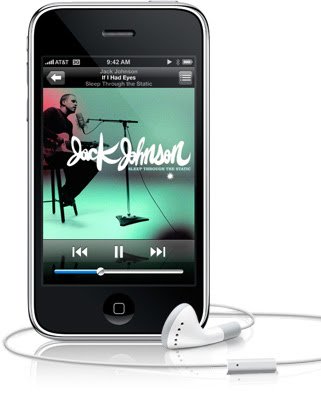
IPOD PROBLEM
· when im using the ipod with the iphone headphones, if i go to pause the song using the button on the headphones and leave it paused for a bit then go to hit it again to play, it wont play and i gotta take the phone out and hit play.
· Troubleshooting iPhone or iPod touch sync issues
· Symptoms
· With MobileMe Push, you can automatically sync your contacts, calendars, and bookmarks from your computer (or MobileMe Calendar and MobileMe Contacts) with your iPhone or iPod touch. If your data does not appear to be syncing to your iPhone or iPod touch, try these steps:
· Resolution
- Make sure your iPhone or iPod touch is up-to-date with the latest software.
- Exit the Push application by pushing the Home button on your iPhone or iPod touch, and then go back into the Push application. For example, if it appears that your calendar data is not syncing, leave Calendar, then from the home screen, go back into Calendar.
- If you are syncing calendars or contacts, view the data on MobileMe Calendar or MobileMe Contacts. If the data does not appear correct there, the issue is not with your iPhone or iPod touch. If you are syncing using a Mac, visit this article for more information. If you are syncing using a PC, visit this article for more information.
- Verify the settings on your device. From the home screen, tap Settings > Mail, Contacts, and Calendars, and then tap your MobileMe account. Confirm that the sliders for the data type you are trying to sync is set to "On".
- Make sure you are able to connect to the Internet. Open Safari, and browse to http://www.apple.com. MobileMe Push requires an Internet connection to sync.
- Confirm that a sync is not already occurring. If a sync is occurring, the activity spinner will display while looking at Safari Bookmarks (if Bookmarks are currently syncing), Calendar (if calendars are currently syncing), or Contacts (if contacts are currently syncing). If a sync is occuring, wait for the sync to complete, and then see if your data is up-to-date.
- Try syncing Contacts/Calendars manually. From the home screen, tap Settings > Fetch New Data > Advanced. Select your MobileMe account with the "Contacts/Calendars" label, and change from Push to Manual. Go back to Contacts or Calendars, and wait for the sync to complete. If this resolves your issue, your device was not automatically syncing as expected. Turn your iPhone or iPod touch off and on again, and then change back from Manual to Push.
- Turn your iPhone or iPod touch off and then back on (if you did not already try this above).
- Turn syncing off for the affected data. From the home screen, tap Settings > Mail, Contacts, and Calendars, and then tap your MobileMe account. Move the slider for the data type that is causing you issues. Wait for confirmation that that data type has been disabled, then press Home. Confirm that the data has been deleted on your phone, and then turn syncing for that data type back on.
- Delete the account from your iPhone or iPod touch. From the home screen, tap Settings > Mail, Contacts, and Calendars, and then tap your MobileMe account. Tap Delete Account. On the Mail, Contacts, and Calendars screen, tap Add Account > MobileMe, and set up your account again.
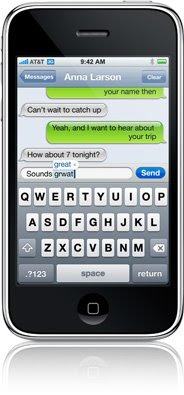
SMS PROBLEMS
· Don't sign up for extra texts during activation. The default SMS-add-ons are expensive and limited. If you did sign up for them then call up AT&T, cancel the add on and request this $5 all-you-can eat unlimited messaging plan instead. TUAW reader Leo signed up and reports the $5 plan is indeed iPhone compatible--at least with the postpaid (normal) phone plan. Be persistent. The AT&T rep may have to search around to find the right plan. Ask for the option that adds unlimited mobile-to-mobile text messaging for $5 per month. Read more about this option at the Howard Forums. Remember, the mobile-to-mobile texts do not include Google SMS, AIM Mobile, Facebook or any other non-cellphone texts. If you use those services, you still might get charged per message. (Update: This unlimited plan may be limited only to other AT&T phones--in which case, you may want to just sign up for the normal messaging plans.) Update 2: According to a post at the MacRumor forums, you can add both that unlimited in-network messaging and 200 additional SMS msgs for $5/month.
· You can send text messages to an iPhone by e-mail. Yeah, yeah, a lot of you already know about this. But many of our readers do not. And for you guys, here's how to do it: send your text message to phonenumber@cingularme.com (e.g. 7035551212@cingularme.com, just use the numbers, no hyphens, etc). Keep your message brief. Both the subject line and the message arrive on the iPhone.
· It costs USD $0.15 to send and receive texts on an iPhone when using a prepaid plan. The money comes out of your account balance. If you're paying, say, 10 cents a minute, then a text would cost you one and a half minutes. Adjust the math according to your specific plan. (Mine is $0.15/minute, so one text is one minute.)
· If you're on a limited prepaid plan, you'll receive a notification after each and every text. Yup, every single text you receive, every single text you send will cause the iPhone to display a message along the lines of "Your last transaction cost 0.15 USD. Your account balance is (whatever) USD". You must tap "Dismiss" every time. What a complete pain. Worse, at least in my experience, you have to dismiss this message before viewing the actual text you just received. AT&T says this is a feature, not a bug: "Your updated balance will be sent to your phone automatically after every call. you can also dial *777# at any time to see your current balance." I've tried this and it works.
· All the Google SMS services work I'm not entirely sure why you'dwant to use Google SMS but I tested it out and it certainly works. I texted fish tacos 80224 to Google and it replied with several local fish taco restaurants. Convenient when you're out of WiFi range and Safari with EDGE is responding too slowly.
· SMS is not email SMS is limited to 160 characters per message.

GPS problems
· The new GPS hardware in the iPhone 3G seems to be having some trouble when not connected to the AT&T 3G network. iPhone Atlas reports that some users are complaining of inaccurate GPS positioning when the 3G data setting (Settings>General>Network>Enable 3G) option is switched to “ON.”
· The iPhone 3G uses aGPS (assisted GPS), which means that the cellular network aids in positioning the handset, giving the GPS hardware less number-crunching to deal with. That means you get super-fast GPS lock-on times. But, it seems that some iPhones are getting conflicting data from the 3G data network and their built-in GPS receivers, leading to incorrect GPS positioning.
· So, for those of you with wonky GPS positioning on the iPhone 3G, try this fix:
- Navigate to Settings>General>Network>Enable 3G and toggle to “OFF”
- Locate yourself using the iPhone 3G’s GPS receiver
- Navigate to Settings>General>Network>Enable 3G and toggle to “ON”
· You should now have accurate GPS positioning information

APP STORES PROBLEM
· It has been a couple weeks since Apple deemed iPhone OS 2.0 to be ripe enough for us to pluck from its digital tree. While third-party software (albeit from a walled garden) is indeed an appetizing treat, widespread reports of drastically reduced battery performance, buggy software, and crashing phones are cropping up like too many worms in a bad apple. Top that off with app update problems, kludgy iTunes syncing, and gagged developers, and the App Store is becoming quite the thorn in the iPhone's side.
· Probably at the top of a growing mountain of complaints about third-party apps is the general unreliability of the App Store itself. Apple seems to be taking money and letting users download apps just fine, but many developers are complaining about extreme delays when submitting updates, some of which are meant to fix data loss problems when updating an app. If an update does make it into the store, iTunes isn't always listing the correct version. NetNewsWire, for example, is actually at version 1.0.7, but the App Store says only 1.0.1.
· Speaking of app updates, the iTunes Store doesn't seem to be able to get its story straight. For starters, a third party has to do Apple's job of providing RSS app update feeds, but the iPhone and iTunes don't always notice the same updates. Many users report that the iPhone's App Store doesn't see any updates at all, and iTunes will sometimes alert users to one number of available updates, but then download more or less once the process is initiated.
· When it comes to actually running applications, users are reporting yet more problems. Some third-party apps are buggy in their own right (for which many updates are sitting idly on Apple's shelves waiting for approval), but a few developers we spoke with have tracked the problems to glaring bugs in iPhone OS 2.0. Some apps repeatedly crash, but a few can crash the entire iPhone and force a reboot that takes noticeably longer than a typical restart. For what it's worth, Apple has posted a support document titled Troubleshooting applications purchased from the App Store. Solutions include signing into the iTunes Store to refresh one's account, reinstalling an app, or restarting and resetting an iPhone or iPod touch.
· About those developers, though. Have you noticed we haven't named any of them or their applications in this piece? It certainly isn't for a lack of looking into this situation—you can thank what is now "lovingly" referred to as Apple's "%$&*ing NDA" (link probably not safe for work, if your workplace doesn't like four-letter words). While the gag Apple imposed on the freely-obtainable iPhone SDK was arguably useful before the iPhone OS 2.0 shipped, developers are increasingly infuriated with the fact that Apple hasn't lifted it yet. The NDA forbids developers from sharing code and techniques, or even speaking to journalists and bloggers about their product and experience.
· As usual in a situation like this, some developers are breaking the perplexing rule and discussing details of iPhone development with the public. Others, who hope to stay within what good graces Apple may have, are flying straight and staying quiet, or at least staying off the record. Paul Kafasis of Rogue Amoeba does a good job of summarizing this collective hair-pulling frustration and how Apple is shooting its platform in the foot with a post aptly titled &*%#ing NDA on O'Reilly's Inside iPhone blog.
· iPhone OS 2.0 and third-party apps were a sweet treat two weeks ago when the new software landed, but now the taste is turning bitter. As users, we have high hopes foriPhone OS 2.1, or even just some 2.0.1 action to squash these obnoxious bugs, but we also hope that Apple will lift its gag order and let developers start making the iPhone OS software platform as good as it should be.
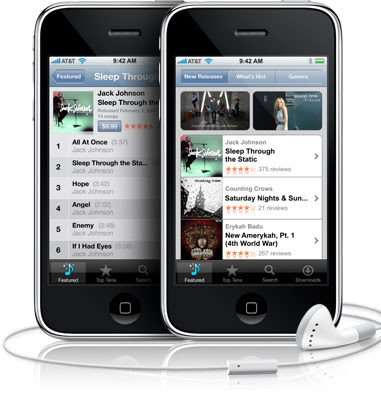
YOU TUBE PROBLEM
· A problem using my youtube on the iPhone. It says cannot connect to youtube..
· To digress slightly, Steve Jobs is using the cunning form of DRM (Digital Restrictions Management) consumer control on the iPhone.
· Users won’t be able to use unless they first sign up with iTunes, whether or not they have any use for it.
· It’s also compelling iPhoners to open AT&T accounts, whether they like it or not, and therein lies the problem.
· The AT&T restriction policy clashes, “head-on with a proclamation by AT&T that the carrier would keep pirated films, music and other content off its network,” says Broadcast Engineering. And, “Since AT&T is the exclusive network for iPhone service, the confusing messages left many scratching their heads,” says the story, continuing:
· “Not only that, AT&T’s customer user agreement currently bans any streaming video over its network. ‘Unlimited plans cannot be used for uploading, downloading or streaming video content (e.g. movies, TV), music or games,’ AT&T’s agreement states.”
· AT&T has yet to say whether it’ll changing the policy for the iPhone to accommodate Steve Jobs’ current marketing claims.
· AT&T’s marriage with Apple was, “extremely controversial because major network providers traditionally route all content neutrally, without discriminating in favor or against a particular content or application,” says Broadcast Engineering.
· problems with wi-fi but got it working ok then for the first time it try to get you tube , but then when i tried again its comes up can not connect to you tube or inter-net.
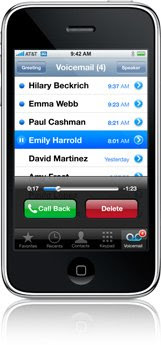
CAMERA PROBLEM
· Apparently some people are reporting problems with the iPhone's camera producing green-tinted pictures. iPhone Atlas suggests that the problem is probably being caused by some defect in the iPhone's automatic white balancing. Fortunately, they also suggest some post-processing solutions with iPhoto or Photoshop.
· Also 2.0 MP camera not worth for 35K.


